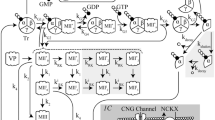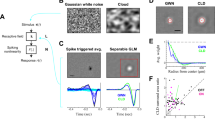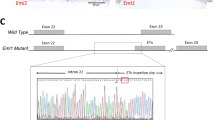Abstract
IN the dark-adapted eye, the amplitude of the early receptor potential (e.r.p.)1 is linearly proportional to the number of molecules of rhodopsin bleached by a flash2. The second of a train of intense flashes evokes a smaller response because less rhodopsin is available2. However, with further stimulation, the e.r.p. reaches a steady voltage, about 10 per cent of the first response. This occurs even though each molecule of rhodopsin should, theoretically, have bleached many times over3. The relationship established by Cone2 breaks down after the second or third maximal flash. The reason for this is that the flash causes regeneration of photopigment from a stable product of bleaching, by a mechanism different from that analysed by Williams3. The regeneration can be demonstrated by exposing the eye to a series of intense flashes (Fig. 1) until the e.r.p. amplitude has reached a stable lower level.
This is a preview of subscription content, access via your institution
Access options
Subscribe to this journal
Receive 51 print issues and online access
$199.00 per year
only $3.90 per issue
Buy this article
- Purchase on Springer Link
- Instant access to full article PDF
Prices may be subject to local taxes which are calculated during checkout
Similar content being viewed by others
References
Brown, K. T., and Murakami, M., Nature, 201, 626 (1964).
Cone, R. A., Nature, 204, 736 (1964).
Williams, T. P., J. Gen. Physiol., 47, 679 (1964).
Hubbard, R., and Kropf, A., Proc. U.S. Nat. Acad. Sci., 44, 130 (1958).
Hubbard, R., and Wald, G., J. Gen. Physiol., 36, 269 (1952–3).
Pak, W. L., and Cone, R. A., Nature, 204, 836 (1964).
Pak, W. L., and Ebrey, T. G., Nature, 205, 484 (1965).
Brown, K. T., Nature, 207, 1249 (1965).
Author information
Authors and Affiliations
Rights and permissions
About this article
Cite this article
ARDEN, G., IKEDA, H. A New Property of the Early Receptor Potential of Rat Retina. Nature 208, 1100–1101 (1965). https://doi.org/10.1038/2081100a0
Issue Date:
DOI: https://doi.org/10.1038/2081100a0
This article is cited by
-
Generation of the Vertebrate Early Receptor Potential and its Relation to Rhodopsin Chemistry
Nature (1968)
-
Die raschen Antworkomponenten der α-Welle im menschlichen ERG
Albrecht von Graefe's Archive for Clinical and Experimental Ophthalmology (1968)
-
Melanin, a Possible Pigment for the Photostable Electrical Responses of the Eye
Nature (1967)
-
A Photoelectric Potential in Invertebrate Cells
Nature (1966)
Comments
By submitting a comment you agree to abide by our Terms and Community Guidelines. If you find something abusive or that does not comply with our terms or guidelines please flag it as inappropriate.



